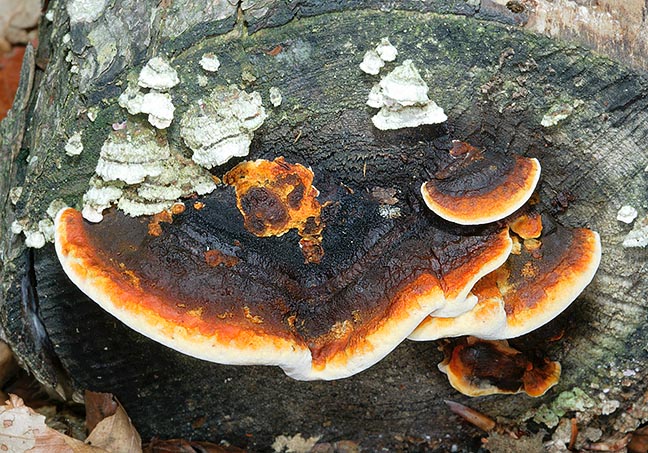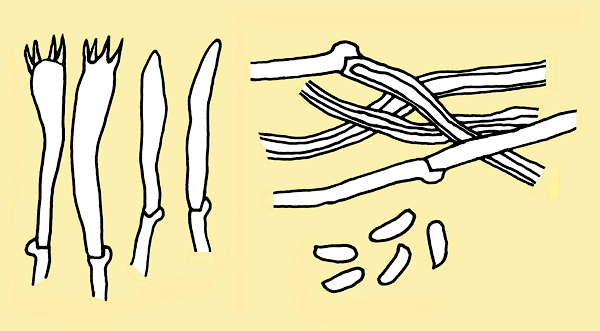
Text © Massimiliano Berretta

English translation by Mario Beltramini

Gloeophyllum sepiarium is a conifer saprophyte attacking also the worked wood © Giuseppe Mazza
Family: Gloeophyllaceae Jülich, 1982.
Genus: Gloeophyllum P. Karsten, 1882.
Gloeophyllum sepiarium (Wulfen : Fries) P. Karsten, 1882.
The term “sepiarium” comes from the Latin “sepiárius” = of the cuttlefishes, of the ink (sépia = cuttlefish, ink + ater = dark, black).
In Italy there are no common names for this species whilst in Spain it is called “Yesquero de las cercas”; in France “Lenzite des clôtures”; in Germany “Zaun-Blättling”; in the UK “Rusty gilled polypore”.
Description of the genus
To the genus Gloeophyllum belong annual or perennial basidiomes, resupinate or pileated, brownish, smooth as well as tomentose, often zoned; the hymenophore can be porous, daedalous or lamellate; the context is coriaceous or woody, brown-reddish or cinnamon. The hyphal system can be dimitic of trimitic, usually with rare binding hyphae; hyaline basidiospores, white in mass, inamyloid, smooth and cylindraceous. It includes species saprophytic of conifers, rarely of broad-leaved trees; they cause the brown rot, especially on the needle-leaved trees. They contain turpentine or similar compounds. The species type is the Gloeophyllum sepiarium.
Description of the species
Cap: annual or perennial basidiomes, sessile of with upper inrolled margin, usually of the same colour of the pileus surface, rarely resupinate, isolated or joined laterally, hirsute, shaggy, zoned, the colour goes from the brownish yellow to the reddish brown, the single fructiferous bodies measure 3-10 cm of length, 2-3 cm of breadth, the thickness does not exceed the cm.
Hymenium: mostly lamellate, with thin gills 3-6 mm wide, entire or toothed, radially placed, at times the gills are anastomosed thus forming mixed zones, porous-lamellate, the frequency is of 1-2 pores per mm and 15-20 gills per cm, measured at the margin; the colour of the gills is ochreous, paler than the context, with edge covered slightly brown pruinous.

Gloeophyllum sepiarium basidia, cystidia, hyphae structure and spores © Pierluigi Angeli
Stipe: absent.
Flesh: homogeneous context, coriaceous, of brown colour, the thickness s of about 5 mm.
Habitat: saprophyte of conifers, rarely on broad-leaved trees, fructifies in dry locations, often it is found on worked wood (fences, piles of timber).
Edibility: of no value.
Reactions: the context becomes black with the KOH.
Microscopy: the hyphal system is trimitic with frequent skeletal brown hyphae, with a diameter up to 6 µm, rare binding hyphae, brown, with diameter up to 5 µm, hyaline generative hyphae with clamp connections having a diameter from 1,5 to 4,5 µm; the cistydioles are hyaline and subulate, 12-35 × 3-7 µm; cylindraceous, hyaline, inamyloid, 9-13 × 3-5 µm.
Remarks: this is a common species, distributed in the temperate zones of the northern hemisphere. It is easy to mistake it with Gloeophyllum abietinum (Bulliard) P.Karsten 1882, growing only on conifers, preferring the spruce, also this one can be found on worked wood, of, as an average, of smaller size and brown-amber then blackish colouration, the gills are 8-12 per cm at the edges, interspersed with anastomosed lamellules, ampler than in Gloeophyllum sepiarium, the cistydia are pointed with thick walls and apical crown of crystals. Gloeophyllum trabeum (Persoon) Murril 1908, prefers the broad-leaved trees and its hymenium is mostly porous-dedalous with pores and gills much thicker than the other two species, smaller spores and tapered cystidia.
Synonyms: Agaricus sepiarius Wulfen 1786 (basionym); Daedalea sepiaria (Wulfen) Fries 1821; Lenzites sepiaria (Wulfen) Fries 1838; Merulius sepiarius (Wulfen) Schrank 1789.
→ For general notions about Fungi please click here.
→ To appreciate the biodiversity of MUSHROOMS please click here.
